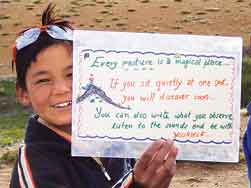Dr. Pranav Trivedi
 Every child of the present age is prone to take the Earth for granted. With humanity living in a myth of ‘control over nature’ through advances in science and technology, this is not an unusual outcome! A child imbibes values and attitudes from the society/culture in which it is born and tends to reflect the general trend of negative attitude towards nature/wildlife. The child is unaware of the impact on the Earth of the materials it uses; endangering the survival of a number of plant and animal species and ecosystems in the process. This lack of understanding about our actions and responsibility towards maintaining life supporting processes on Earth, a highly reduced/diluted direct experience/appreciation of nature combined with the breakdown of the socio-cultural institutional mechanisms for the transfer of local knowledge/perspectives about our links with our bio-physical world, has severely influenced the awareness of nature among today’s children.
Every child of the present age is prone to take the Earth for granted. With humanity living in a myth of ‘control over nature’ through advances in science and technology, this is not an unusual outcome! A child imbibes values and attitudes from the society/culture in which it is born and tends to reflect the general trend of negative attitude towards nature/wildlife. The child is unaware of the impact on the Earth of the materials it uses; endangering the survival of a number of plant and animal species and ecosystems in the process. This lack of understanding about our actions and responsibility towards maintaining life supporting processes on Earth, a highly reduced/diluted direct experience/appreciation of nature combined with the breakdown of the socio-cultural institutional mechanisms for the transfer of local knowledge/perspectives about our links with our bio-physical world, has severely influenced the awareness of nature among today’s children.
The world of a 12-year old child residing in a remote village in the Spiti and Ladakh regions of the Indian Trans-Himalaya is no different. From a generation of children who enjoyed a semi-wild existence among the lofty mountains, following the herds of yak, goats and sheep; attuned to the change of seasons, watching wildlife each day and knowing a vast range of local flora and fauna; the present day child spends six to seven hours in the classroom of a local school and almost the whole day in some kind of constructed space if attending a residential one. She studies about the world while mostly alienated from her local environment. To her parents, the knowledge of local plants and their uses just came naturally – through direct contact and passed on by the earlier generations, or from more knowledgeable friends with whom they grazed livestock or went collecting dung and useful plants. But, for this child there’s no meaningful way to connect with her surrounding landscape or the wild flora and fauna. The space and wildlife are still there, just a few yards away from either school or home, yet she does not have any link with these elements of her environment. This is the situation that most rural children face today. In a sense, it is worse than urban children whose parents or schools expose them to some form of ‘nature’ in the way of visits to protected areas, zoos and nature parks. Since human survival is dependent on the health of the rest of life on Earth and their interactions with the physical environment, this ‘disconnect’ could prove perilous for our species.
If children are provided with opportunities to be out-of-doors and interact with nature using all their senses, this missing link can be re-established. Bridging this disrupted link, which is so crucial not just for nature conservation but also for healthy development of the child and expression of her creativity is the focus of this article. Now regarded as a psychological discipline called eco-psychology and considered a key part of the pedagogy for education in general, this avenue has not been explored adequately in the Indian context. For the past five years (2007-11), we have engaged with children to figure out how they view their natural environment and wildlife and whether we can help bring a change in their perspective.
The author obtained his MSc in Wildlife Science from the Wildlife Institute of India, a post-graduate certificate in environmental education (PGCEE) from the University of Strathclyde, UK and a PhD in wildlife science from the Saurashtra University, India. His major interest is in human-nature relationship and environmental interpretation. He presently works with Nature Conservation Foundation and Snow Leopard Trust as Head of Education & Outreach and Director of Conservation (India Program) respectively.
